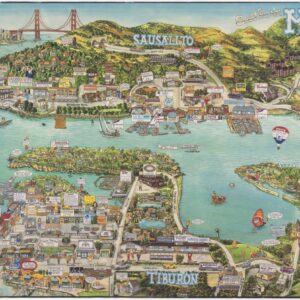1863 Colton map of the Southwest with earliest Nevada-Arizona border.
Colton’s Map of California, Nevada, Utah, Colorado, Arizona & New Mexico
Out of stock
Description
Fine, early edition of G.W. & C.B. Colton’s map of the Southwest, showing the earliest Nevada-Utah Territorial Border shortly after the boundary line was shifted east from 116th meridian to the 115th meridian in 1862.
Nevada is truncated at the bottom, so that Las Vegas is in Arizona. Utah is wider than its final configuration. The boundary between Nevada and Utah would be moved to the 114th meridian in 1866.
While at first look the map appears similar to Johnson’s map of the same period, this one is vastly more detailed. There are many mining districts named and outlined in southern California. A number of early wagon roads are shown, with U.S. forts each marked with American flags. The routes surveyed by Emory, Simpson, Albert & Peck, Fremont, Gunnison, and others are shown, with years relevant to the survey.
The Emigrant’s Road, Fredonyer’s Trail and Pass, Pony Express and U.S. Mail Routes are shown.
Excellent topographical detail, which includes elevations. Many Indian tribes and other interesting places are noted, along with annotations.
Cartographer(s):
Colton & Co: The Colton mapmaking company was founded by Joseph Hutchins Colton in 1831. A native son of Massachusetts, Colton set up his firm in the metropolis of New York, drawing at first on established cartographers and engravers (e.g. David H. Burr and Samuel Stiles) to license maps. By the 1840s, however, the Colton firm was producing its own maps. They produced anything the market desired, from massive and impressive wall-maps to pockets guides, folding maps, immigrant guides, and atlases. One of the things that set the Colton company aside from many of its contemporaries in terms of quality, was the insistence that only steel plate engravings be used for Colton maps. These created much more well-defined print lines, allowing even minute features and labels to stand out clearly.
In the 1850s Colton’s two sons, George Woolworth and Charles B., were brought on board to the firm. This inaugurated a process of expansion in which the company began taking international commissions and producing wholly independent maps and charts.
Condition Description
Minor discoloration along centerfold; slightly uneven trim along top margin.
References
![The Original Silicon Valley Map & Calendar [1994]](https://neatlinemaps.com/wp-content/uploads/2021/06/NL-00909_Thumbnail-300x300.jpg)
![The Original Silicon Valley Map & Calendar [1994]](https://neatlinemaps.com/wp-content/uploads/2021/06/NL-00909_Thumbnail.jpg)





